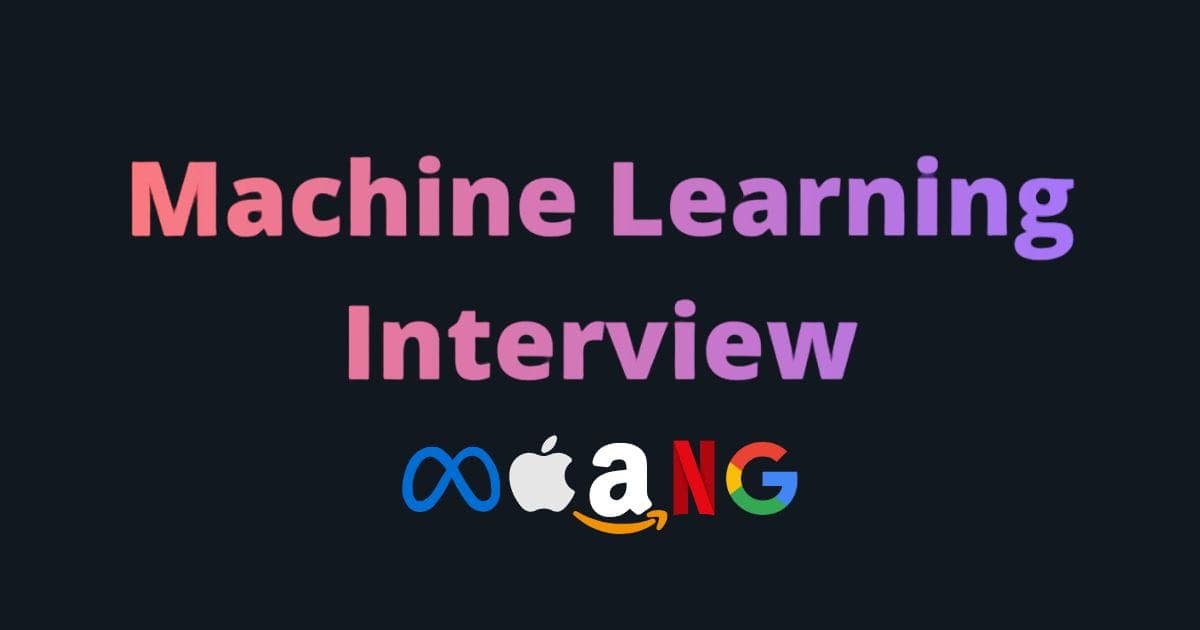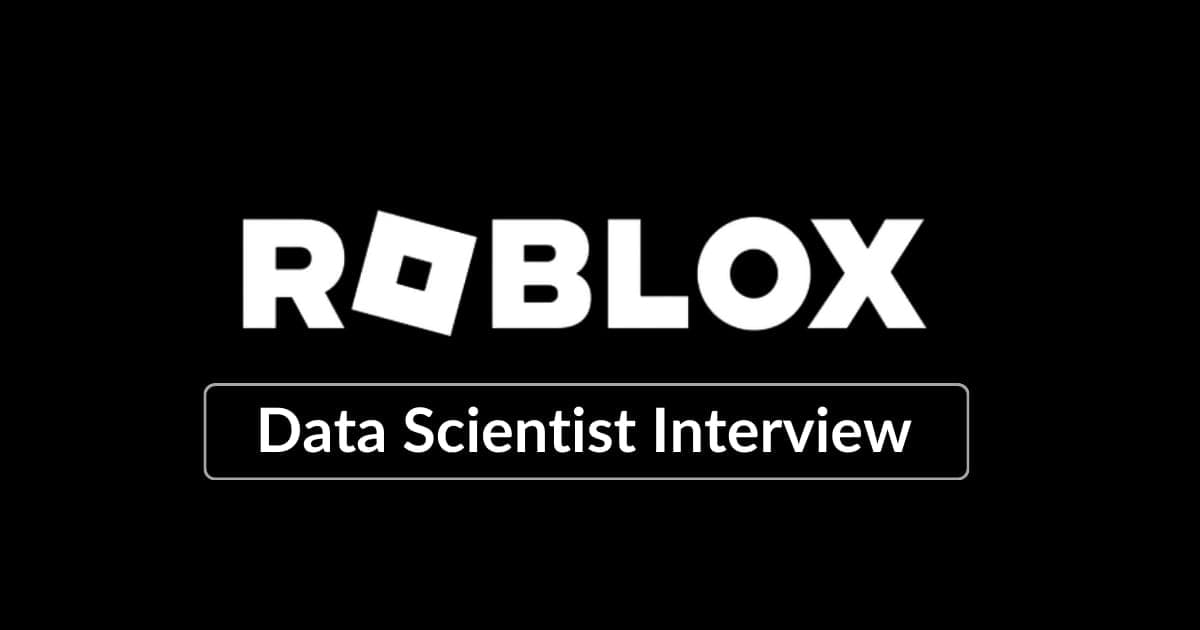Looking for REAL machine learning interview questions asked in FAANGs and startups? Here's a comprehensive guide with 120 REAL questions!
These questions are fair game across data scientist, ML engineer and LLM engineer interviews. Companies such as Google, Amazon, Open AI, Meta, Stripe, McKinsey and much more, all ask machine learning questions.
We will explore the question areas, uncover tips, and provide you with a detailed list of interview questions you can use to ace the interviews!
Let's get started👇
📚 ML Interview Areas
Area 1 - ML Coding
ML coding is similar to LeetCode style, but the main difference is that it is the application of machine learning using coding. Expect to write ML functions from scratch. In some cases, you will not be allowed to import third-party libraries like SkLearn as the questions are designed to assess your conceptual understanding and coding ability.
# Sample Questions
1. [Uber] Write an AUC from scratch using vanilla Python
2. [Google] Write the K-Means algorithm using Numpy only
3. [Startup] Code Gradient Descent from Scratch using Numpy and Scipy only💡For more details, consider joining the DS Interview MasterClass or ML Engineer Interview MasterClass led-by FAANG ML instructors. We discuss these with hands-on exercises in a live format!
Area 2 - ML Theory (”Breath”)
These assess the candidate’s breath of knowledge in machine learning. Conceptual understanding of ML theories including the bias-variance trade-off, handling imbalanced labels, and accuracy vs interpretability are what’s assessed in ML theory interviews.
# Sample Questions
1. [Amazon] Explain how the cross-validation work
2. [Etsy] How do you handle imbalanced labels in classification models
3. [McKinsey] What is the variance-bias trade-off?
Area 3 - ML Algorithms (”Depth”)
Don’t confuse ML algorithms (sometimes called “Depth”) as the same coverage as ML “Breath”. While ML breath covers the general understanding of machine learning. ML Depth, on the other hand, assesses an in-depth understanding of the particular algorithm. For instance, you may have a dedicated round just focusing on the random forest. E.g. Here’s a sample question set you could be asked in a single round at Amazon.
# Sample Questions
1. [Amazon] What is the pseudocode of the Random Forest model?
2. [Amazon] What is the variance and bias of the Random Forest model?
3. [Amazon] How is the Random Forest different from Gradient Boosted Trees?
Area 4 - Applied ML Cases
These are solve ML cases in the context of a business problem. Scalability and productionization are not the main concern as they are more so relevant in ML system design portions. Business case could be assessed in various form; it could be verbal explanation, or hands-on coding on Jupyter or Colab.
# Sample Questions
1. [Google] Given a dataset that contains purchase history on PlayStore, how would you build a propensity score model?
2. [PayPal] How would you build a fraud model without labels?
3. [Apple] How would you identify meaningful segmentation?
If you are looking for detailed solution
If you are looking for detailed solution solved by a FAANG ML instructors, join the Ultimate Interview Prep, which comes with self-paced content, mock interview recordings, and premium Slack community group!
Area 5 - ML System Design
These assess the soundness and scalability of the ML system design. They are often assessed in the ML engineering interview, and you will be required to discuss the functional & non-functional requirements, architecture overview, data preparation, model training, model evaluation, and model productionization.
# Sample Questions
1. [Google] Build a real-time translation system
2. [Uber] Build a real-time ETA model
3. [Amazon] Build a recommender system for product search
📚 ML Questions in Data Scientist & ML Engineer Interviews
Depending on the tracks, the type of ML questions you will be exposed to will vary. Here are some examples. Consider the following questions posed in various roles:
- Product Analyst - Build a model that can predict the lifetime value of a customer
- Data Scientist (Generalist) - Build a fraud detection model using credit card transactions
- ML Engineering - Build a recommender system that can scale to 10 million daily active users
For product analyst roles, the emphasis is on the application of ML on product analysis, user segmentation, and feature improvement. Rigor in scalable system is not required as most of the analysis is conducted on offline dataset.
For data scientist roles, you will most likely be assessed on ML breath, depth, and business case challenges. Understanding scalable systems is not required unless the role is more focused on “full-stack” type of data science role.
For ML engineering role, you will be asked coding, ML breath & depth and ML system design design questions. You will most likely have dedicated rounds on ML coding and ML system design with ML breath & depth questions peppered throughout the interview process.
✍️ Common Machine Learning Algorithms
In general you should have a in-depth understanding of the following algorithms. Understand the assumption, application, trade-offs and parameter tuning of these 7 ML algorithms. The most important aspect isn’t whether you understand 20+ ML algorithms. What’s more important is that you understand how to leverage 7 algorithms in 20 different situations.
- Linear Regression
- Logistic Regression
- Decision Tree
- Random Forest
- Gradient Boosted Trees
- K-Means
- Dense Neural Networks
Learn the ins-and-outs of these algorithms by learning to write the pseudocode from scratch. These will be helpful in ML coding and ML depth interviews!
📝 More Machine Learning Questions
These questions are fair game across data scientist, ML engineer and LLM engineer interviews. Companies such as Google, Amazon, Open AI, Meta, Stripe, McKinsey and much more👇
Easy Machine Learning Interview Questions
- What is the difference between supervised and unsupervised learning?
- Can you explain the concept of overfitting and underfitting in machine learning models?
- What is cross-validation? Why is it important?
- What is the bias-variance tradeoff?
- How would you validate a model you created to generate a predictive analysis?
- What is the role of the cost function in machine learning algorithms?
- What is the curse of dimensionality? How do you avoid this?
- What is "Naive" about the naive bayes?
- What is semi-supervised learning? Give examples of when it's useful.
- What is self-supervised learning? How is it different from unsupervised learning?
- What is curriculum learning? When might it be beneficial?
Feature Engineering & Data Preprocessing
- How do you handle missing or corrupted data in a dataset?
- How would you handle an imbalanced dataset?
- Can you explain the concept of "feature selection" in machine learning?
- How do you handle categorical variables in your dataset?
- How do filtering and wrapper methods work in feature selection?
- Describe a situation where you had to handle missing data. What techniques did you use?
- What is principal component analysis (PCA) and when is it used?
- What's the difference between PCA vs ICA?
- How do you handle time-based features in a machine learning model?
- What is feature hashing? When would you use it?
- How do you handle hierarchical categorical variables?
- What are embedding layers and when should you use them?
- Explain different strategies for handling outliers in different ML algorithms.
Tree-Based Model Interview Questions
- Describe how a decision tree works. When would you use it over other algorithms?
- What is the difference between bagging and boosting?
- What is entropy and how is it used in decision trees?
- How do decision trees handle continuous numerical variables?
- What is information gain and how does it relate to decision tree construction?
- Explain the concept of pruning in decision trees.
- What are the primary differences between the CART, ID3, and C4.5 decision tree algorithms?
- How do decision trees deal with missing values during both training and prediction?
- Explain the concept of bootstrapping in relation to random forests.
- How does feature selection work in a random forest as compared to a single decision tree?
- Why might a random forest be less prone to overfitting than a single decision tree?
- How can you estimate the importance of a feature using a random forest?
- What are the key hyperparameters to tune in a random forest model?
- How does XGBoost differ from traditional gradient boosting?
- What is the difference between hard and soft voting in ensemble methods?
- How does LightGBM differ from XGBoost?
Deep Learning Interview Questions
- What are some of the advantages and disadvantages of a neural network?
- Can you describe how a convolutional neural network (CNN) works?
- Can you describe what an activation function is and why it is used in an artificial neural network?
- What are the vanishing and exploding gradient problems, and how can they be addressed?
- Explain the difference between batch normalization and layer normalization?
- How does LSTM differ from a standard RNN? What problems does it solve?
- What is the role of dropout in neural networks? How do you choose the dropout rate?
- Explain the concept of attention mechanisms in neural networks.
- What is transfer learning? When and why would you use it?
- How does a GAN (Generative Adversarial Network) work? What are its applications?
- What is the difference between same and valid padding in CNNs?
- Explain how Word2Vec works. What are CBOW and Skip-gram models?
- What are transformers and how do they differ from traditional sequence models?
Regression Interview Questions
- What are the assumptions behind a linear regression model?
- What's the impact of outliers in a linear regression model?
- How do you interpret logistic regression model?
- What's the impact of outliers in the logistic regression model?
- How do you handle multicollinearity in a regression model?
- Explain the difference between ridge regression and lasso regression?
- What is elastic net? How does it regularize parameters?
- In logistic regression, how do you interpret the coefficients of the predictors?
- What is the purpose of the R-squared statistic in a linear regression model?
- What is the confidence interval of the logistic regression model?
- How do you interpret the coefficient of a logistic regression model?
- Describe the difference between simple linear regression and multiple linear regression.
- What are the key differences between a linear regression and a polynomial regression model?
- How do you detect and handle outliers in regression analysis?
- Can you explain the principle of a support vector machine (SVM)?
- Can you explain the difference between L1 and L2 regularization methods?
Advanced Machine Learning Interview Questions
- What is the difference between stochastic gradient descent (SGD) and batch gradient descent?
- Which metrics would you use for binary classification? How about for multi-class classification or regression?
- How do you ensure that your machine learning model is not just memorizing the training data?
- How do you improve the speed of model training?
- How do you generate prediction interval from a model like the random forest?
- What's the difference between AUC and accuracy?
- Describe a situation where ensemble methods improved your model's performance.
- How do you deal with large datasets that don't fit into memory?
- How learning rate scheduling work? What are different scheduling strategies?
- What is early stopping? How do you implement it effectively?
- Explain the concept of model distillation. When would you use it?
- How do you handle class weights in an imbalanced dataset?
- What is the difference between model parallelism and data parallelism?
- What metrics would you use to evaluate a recommendation system?
- How do you balance model latency requirements with model accuracy in production systems?
Production & MLOps Interview Questions
- How would you deploy a machine learning model in a production environment?
- Describe a situation where you had to tune hyperparameters. Which methods did you use and why?
- How do you implement online learning for a model in production?
- What is A/B testing in the context of ML models? How do you design such tests?
- How do you monitor model drift in production?
- What are shadow deployments in ML? When would you use them?
- How do you handle version control for ML models?
- What is the difference between model serving and batch prediction?
- What is the difference between model registry and model versioning?
- How do you implement A/B testing for ML models in production?
- What is the role of feature stores in ML systems?
- How do you handle model governance and compliance in production ML systems?
- What strategies do you use for ML pipeline orchestration?
- How do you handle concept drift versus data drift in production ML systems?
- How do you ensure model fairness and handle bias in ML systems?
Time Series & Clustering Interview Questions
- How do you build a forecasting model?
- How does ARIMA work?
- What is the difference between ARIMA and SARIMA?
- How does the k-means algorithm work?
- How does Gaussian mixture work?
- Explain how DBSCAN clustering works. When would you use it over k-means?
💡 Prep Tips
Tip 1 - Understand How ML Interviews are Screen
The typical format is 20 to 40 minutes embedded in a technical phone screen or a dedicated ML round within an onsite. You will be assessed by Sr./Staff-level data scientist or ML engineer. Here’s a sample video. You can also get 1:1 personalized coaching with an Ex-FAANG instructor on DataInterview. You can also watch this mock interview video here based on Amazon's Machine Learning Interview.

Tip 2 - Practice Explaining Verbally
Interviewing is not a written exercise, it’s a verbal exercise. Whether the interviewer asks you conceptual knowledge of ML, coding question, or ML system design, you will be expected to explain with clarity and in-details. As you practice interview questions, practice verbally.
Tip 3 - Join Community Group
Finding study buddies is one of the best ways to prepare for interviews. Join community groups like the DataInterview Premium Community and you will be readily be able to network with coaches and candidates currently preparing for interviews at reputable companies like Google, Meta, Stripe and more! Spend an hour a week and review sample questions together.



